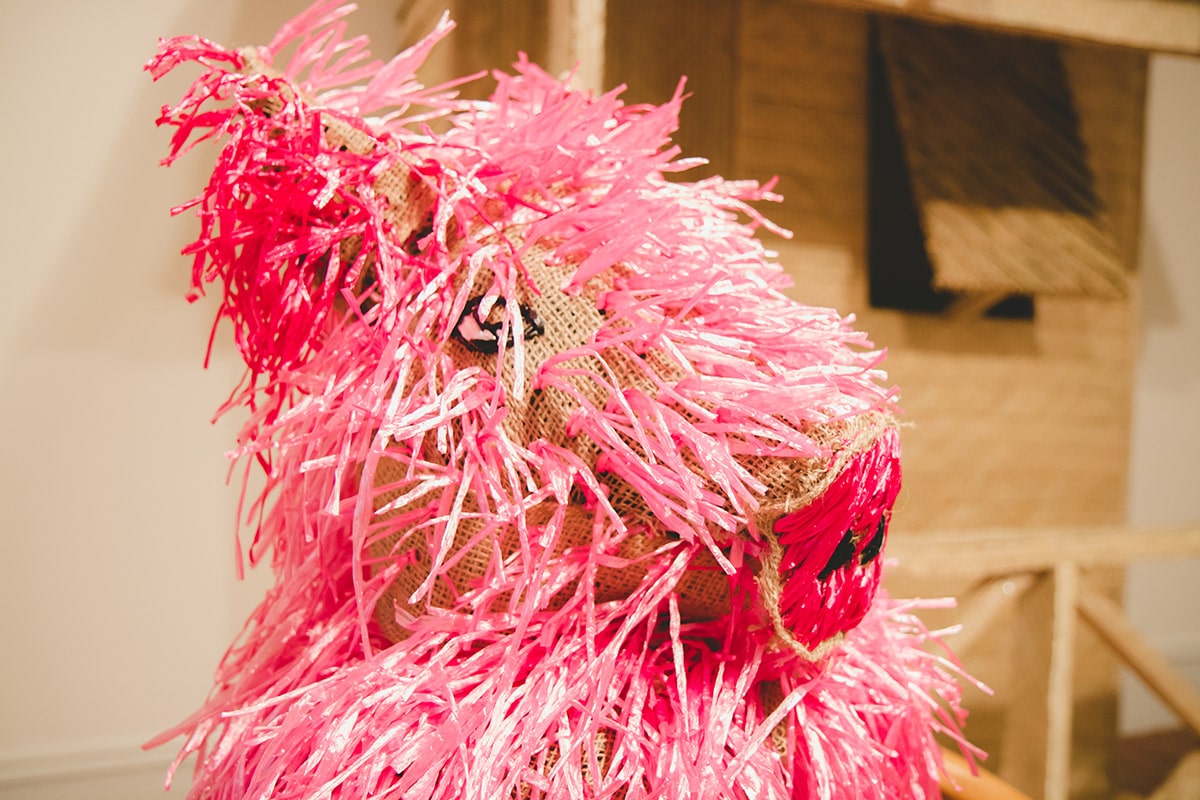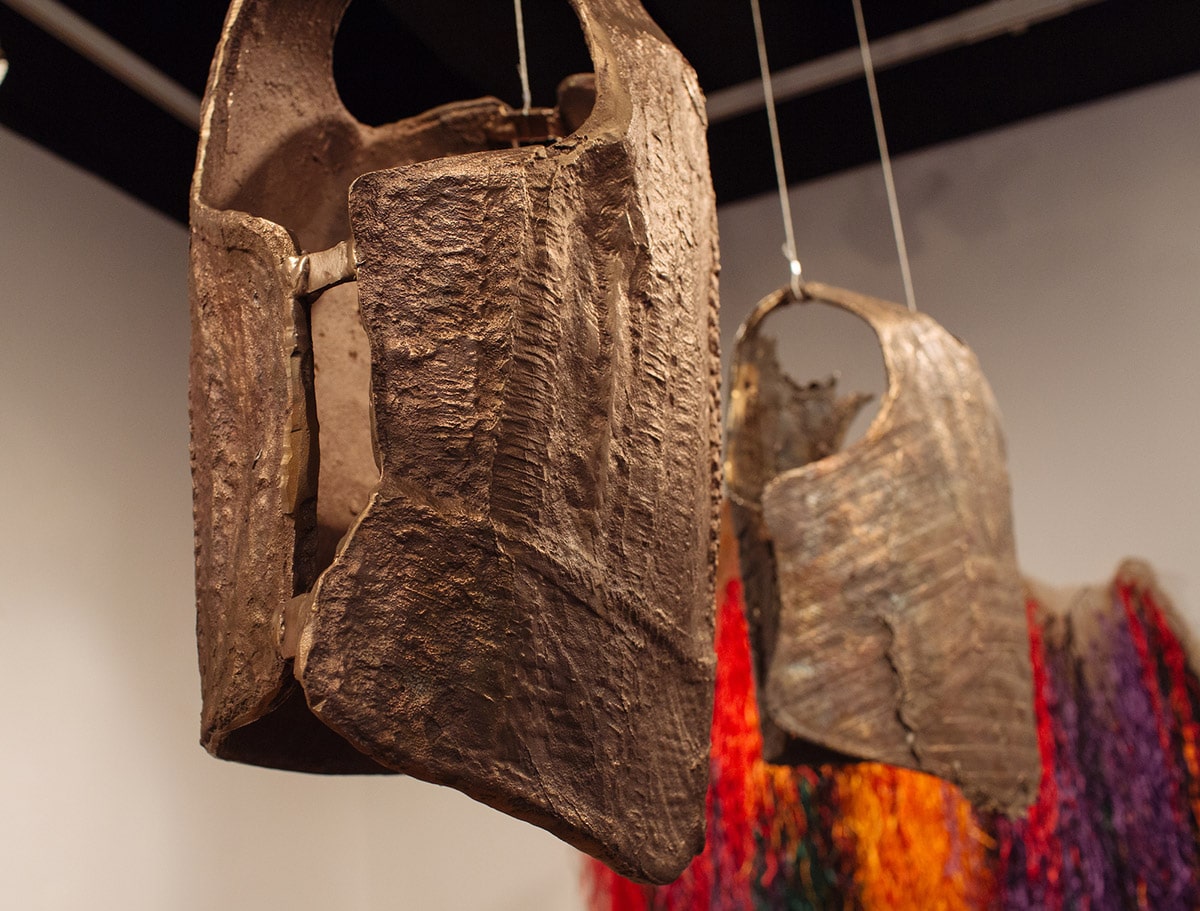The Straw Paradox
Natalie Willis ·

Averia Wright’s The Straw Paradox: The Pig That Built His House of Straw is something of a paradox in the name itself. Straw work in The Bahamas is a bit of a misnomer – it isn’t really “straw” in the Western traditional sense at all. Our straw is not made of barley, wheat or things of that ilk at all, rather, it is a pale gold weaving made of Silver Top Palm. Wright comes from a family of straw market women, and has been plaiting her whole life.
When asked why she has such a preoccupation with the material of late, her response is surprising: “Normally when I get this question or anything related to straw work, I always give the precursor that I hate straw. A lot of people who are familiar with my practice don’t get that from the work, they say ‘you don’t look like you hate straw, you look like you love straw!’ But when I say that I hate straw, I mean that my emotional response to it is based on my upbringing. My mum, my grandmother and three of my aunts were straw vendors. If you’ve been around my family – even if you’re a friend or a passing person and you’ve been to any of our homes – straw is everywhere, raffia is everywhere. You’re gonna get put to work.”

The work is clearly visible. This clapboard-style structure, covered in a facade of hand-woven straw plait, is immediately impressive in its scale and in just how clearly the idea of labour is present in the work. Straw work is work. Wright continues: “They say many hands make light work, and from the time I was 3 years old, I’ve been sewing and plaiting raffia and straw and so forth. Art making for me has been in the commercial area of straw and craft work and at the time, growing up, I hated it. Every waking moment was consumed with it. It was interesting for me to consider art as a career, because I didn’t know that I was interested in art until I was in the 9th grade. So the question really was “what is art to me?” because I hated this material so much and struggled with the craft that I didn’t fully understand that I was interested in art. I kinda held off for a long time on working with the material, and when I was at the University of Tampa in Florida, Kendra Frorup was my lecturer and she always told me “you need to work with straw! You need to work with straw!” and my response was always “never, never, NEVER!” This is why they say never say never!”
It was that after Wright returned home after achieving her MFA in Sculpture and Expanded Practice at Ohio University that began her research into straw. She has spent the last 7 months digging into this part of her heritage, and indeed wider Bahamian heritage. Straw work in The Bahamas is gendered business, and largely remains so today. Though the art was practiced throughout the archipelago, the straw industry as we know it began in the 1920s by a group of industrious women from Fox Hill, here in New Providence – namely, Estelle, Melissa and Manette Davis, Eunice Demeritte, and Rebecca Jarvis – who sold their wares in Nassau at Rawson Square to tourists and locals. From the 20s to contemporary designer straw work (made popular by Harl Taylor), the industry has shifted and grew with the times – but with that growth also comes demand in an environment where Bahamian green land is shrinking in the name of development.

“What is interesting is that when I go to the plaiters to get straw for my family and hear their stories, a few things stick out to me. The Harl Taylor bag phenomenon and designer straw bags changed the game for plaiters because the demand was there. As a result, the cost of the material and straw and plait went up. Now the demand is higher, the cost of the straw is higher, and the commercial goods that would be regularly sold at the straw market had to go up. This makes it difficult because tourists feel you’re overcharging for things you’ve previously charged very little for. So that whole idea of supply and demand plays into the sustainability of it. The reality is that as more development happens in the Family Islands, where these Silver Top Palms and different types of plait are found, they have to go further and further out to find them; into different settlements to get the straw, so they’re charging more for their bundles. Naturally, the plaiter has to charge more for her plait, and has to get it to Nassau, it’s a chain.”
How do we preserve our cultural patrimony and heritage?
With the passage of Hurricane Dorian this year, and Hurricanes Joaquin and Irma and Matthew in recent years, the resource of Silver Top Palm is shrinking even more quickly. This throws the issues of development and (lack of) sustainability into even more acute urgency. Family Islanders have a wholly different tie to the landscape compared with those of us in the capital. While not everyone makes their living in the stereotypical ways of “da island” (fishing, farming, straw work etc.), it is still a vital part of the economy and culture of these islands and has been so for a couple hundred years. Straw work has shifted and adapted with the time in terms of design, but not in terms of sourcing material and this is part of the problem for Wright – how do we preserve this culture? How do we not lose our cultural patrimony and heritage?
“[Sustainability] is something that’s popped up this time in particular in my work but I feel I’m just newly delving into it. I spoke with someone whose family plaits straw in Long Island, and she told me “The resource will never go away”. A lot of people think that, and it got me thinking about the significance of that idea and the implications of it on how we think about straw work. She believes that as generations like us grow up with it in our families and get older, that we see the way that our families and parents have survived. She thinks that because of this we will look to the trades they have developed to sustain themselves, and that we will pick it up eventually when things get tough – bills come in and we need to find a way to make it. I don’t know if that’s entirely true though, for me that’s the question. For instance, my mum’s wholesale business is growing and she employs a lady who plaits for her and this woman is in her 80s. She prays for her a lot! Because how do you possibly find someone to replace her work in our current age? Something has to be done, you can’t assume everything will just be fine and continue on in perpetuity. If you see a problem arising, you need to fix it or address it.”
We must build stronger structures than straw foundations to keep industries like this going, as Wright implies in the title of this installation. It may look fun and enticing as a work, with a playful pink raffia pig and the facade of a straw home, but this device is to draw us in to truly consider the impact of our shifting and ever-threatening environment (both globally and economically) on these parts of our history and culture as people of The Bahamas.
